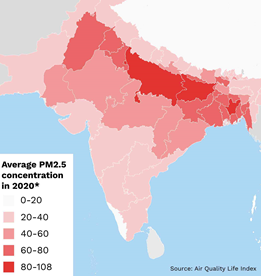

Context
Recently, the World Bank released a report titled 'Striving for Clean Air: Air Pollution and Public Health in South Asia'.
Background:
- Persistently hazardous levels of air pollution have caused public health crises in South Asia demanding urgent action.
- Using a modelling approach over South Asia as a whole, the WB report lays out multiple scenarios and costs involved in reducing the region’s exposure to particulate matter (PM)
Highlights of the Report:
- Over 60% of South Asians are exposed to an average of 35 µg/m3 of PM2.5
- In some parts of the Indo-Gangetic Plain (IGP) it spiked to as much as 100 µg/m3 – nearly 20 times the upper limit of 5 µg/m3 recommended by the WHO.
- According to a World Bank report, India has six large airsheds, some of them shared with Pakistan, between which air pollutants move. They are:
- West/Central Indo-Gangetic Plain (IGP) that included Punjab (Pakistan), Punjab (India), Haryana, part of Rajasthan, Chandigarh, Delhi, and Uttar Pradesh.
- Central/Eastern IGP: Bihar, West Bengal, Jharkhand, Bangladesh
- Middle India: Odisha/Chhattisgarh
- Middle India: Eastern Gujarat/Western Maharashtra
- Northern/Central Indus River Plain: Pakistan, part of Afghanistan; and
- Southern Indus Plain and further west: South Pakistan, Western Afghanistan extending into Eastern Iran.

- Dominant Sources of Air Pollution: These include the combustion of solid fuels for cooking and heating, emissions from small industries such as brick kilns, burning of municipal and agricultural waste, and cremation.
- It highlights the interdependence in air quality within airsheds in South Asia, which is necessary for pollution control.
|
What are Airsheds?
|
Suggestion
- Full coordination between airsheds: Curbing air pollution requires not only tackling its specific sources, but also close coordination across local and national jurisdictional boundaries.
- Coordination between airsheds, would cut the average exposure of PM 2.5 and save more than 7,50,000 lives annually.
- Establish a dialogue on air pollution: Scientists from India, Pakistan, Nepal, Bangladesh and other South Asian countries must establish a dialogue on air pollution to tackle it with an ‘airshed approach’.
- In ASEAN, Nordic regions and across China, air pollution is tackled in this way.
- All feasible measures it would bring pollution below that number.
Indian efforts to curb air pollution
- National Clean Air Campaign (NCAP): Launched in 2019, it aims to reduce air pollution in 131 of India’s most polluted cities.
- (SAFAR) Portal: SAFAR is a national initiative introduced by the Ministry of Earth Sciences (MoES) to measure the air quality of a metropolitan city.
- Air Quality Index: AQI has been developed for eight pollutants viz. PM2.5, PM10, Ammonia, Lead, nitrogen oxides, sulphur dioxide, ozone, and carbon monoxide.
- Graded Response Action Plan (for Delhi)
- National Clean Air Campaign (NCAP): It aims to reduce (40% over 2017 levels by 2025-26) air pollution in 131 of India’s most polluted cities.
- National Air Quality Monitoring Programme (NAMP): Under NAMP, four air pollutants viz. SO2, NO2, PM10, and PM2.5 have been identified for regular monitoring at all locations.


